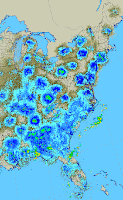 Last night all signs indicated that a major push of migrant songbirds was underway. For one of the first times this fall, we had a strong cold front with north or northwest winds. The NEXRAD radar also lit up along the east coast after dark. (The picture at right is from about midnight; the blue circles represent flocks of migrating birds.) So early this morning my mother and sister and I went out for some birding.
Last night all signs indicated that a major push of migrant songbirds was underway. For one of the first times this fall, we had a strong cold front with north or northwest winds. The NEXRAD radar also lit up along the east coast after dark. (The picture at right is from about midnight; the blue circles represent flocks of migrating birds.) So early this morning my mother and sister and I went out for some birding.
We went over to a stretch of the Delaware and Raritan Canal nearby. The canal towpath along this stretch is a narrow embankment with edge/woods habitat in between the canal and the Raritan River. While it is not a classic migrant trap, it provides enough habitat to attract songbirds and good angles for viewing them.
No sooner were we on the towpath than Belinda spotted a red-breasted nuthatch; these seem to be quite numerous in central Jersey this fall. A few warbling vireos were warbling in the same vicinity. On the rest of the walk, we ran into a few mixed flocks of tufted titmice, Carolina chickadees, and white-breasted nuthatches, which passed overhead in noisy fashion. The neat thing about fall birding is that these noisy commoners often travel in the company of less common migrant warblers. Such was the case today.
With one of the mixed flocks, we found a trio of American redstart, blackpoll warbler, and red-eyed vireo. Farther down the towpath, we encountered another noisy mixed flock. This time the warbler action started with a first fall female black-throated green and a Nashville warbler. They were followed by more redstarts, a black-throated blue, and a magnolia warbler.
Then I spotted a warbler I could not quite place. At first I thought magnolia because it had streaks down the sides, but the tail was not right. It sort of looked like a pine warbler, but the streaking was black, not olive, and too crisp; the habitat was wrong, anyway. Then I thought Cape May, but that seem quite right, either. So I committed the field marks to memory and moved on. When I got a chance to consult my Dunn and Garrett later, I realized that it was indeed a Cape May warbler, probably a first fall male. The reason I dismissed that possibility at first is that I am more familiar with the spring adult male form that has chestnut cheeks and bold white wing patches. Other forms have olive cheeks and less bold wing bars.
Later on, a common yellowthroat rounded out the warbler list for the morning. After we walked about a mile down the path, it was time to leave. Eight warbler species, with one being a Cape May, is not bad at all for a local patch. It was the best migrant day I have seen so far this fall.
BIRD SPECIES: 36
Double-crested Cormorant
Great Blue Heron
Great Egret
Canada Goose
Mallard
Osprey
Ring-billed Gull
Mourning Dove
Belted Kingfisher
Red-bellied Woodpecker
Downy Woodpecker
Hairy Woodpecker
Northern Flicker
Carolina Wren
Gray Catbird
American Robin
Carolina Chickadee
Tufted Titmouse
Red-breasted Nuthatch
White-breasted Nuthatch
Blue Jay
American Crow
European Starling
Warbling Vireo
Red-eyed Vireo
Nashville Warbler
Magnolia Warbler
Cape May Warbler
Black-throated Blue Warbler
Black-throated Green Warbler
Blackpoll Warbler
American Redstart
Common Yellowthroat
Song Sparrow
Northern Cardinal
American Goldfinch



